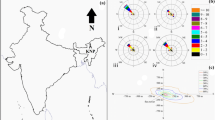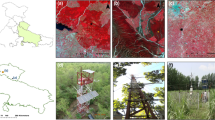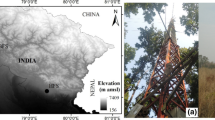Abstract
Carbon dioxide (CO2) is the key atmospheric gas that controls the earth’s greenhouse effect, and forests play a major role in abating the atmospheric CO2 by storing carbon as biomass. Therefore, it is vital to understand the role of different forests in regulating the spatiotemporal dynamics of atmospheric CO2 concentration. In this study, we have used eddy covariance (EC) tower-based atmospheric CO2 concentration measurements and satellite-retrieved column average CO2 concentration of 2018 to understand the diurnal and seasonal dynamics of atmospheric CO2 concentration over the sub-tropical forest in the foothills of northwest Himalaya, Uttarakhand, India. EC study revealed that the CO2 concentration over the forest canopy peaks during mid-night to early morning and drop to a minimum during the afternoon. On a monthly scale, peak atmospheric CO2 concentration was observed during July in both the sites, which was a result of more release of CO2 by the forest ecosystem through ecosystem respiration and microbial decomposition. Enhanced photosynthetic activities during the late monsoon and post-monsoon resulted in the decrease of atmospheric CO2 concentration over the forest ecosystem. Among the meteorological variables, rainfall was found to have the highest control over the seasonal variability of the atmospheric CO2 concentration. Orbiting Carbon Observatory-2 (OCO-2) satellite-retrieved column average CO2 (XCO2) was also examined to comprehend its reliability on an ecosystem scale. The OCO-2 retrieved XCO2 value was higher than the EC carbon flux tower-measured atmospheric CO2 concentration, which might be due to differences in the vertical resolution of the CO2 column and scale difference. However, the monthly atmospheric XCO2 retrieved from OCO-2 strongly adheres with the ground-measured monthly pattern. Our study highlights that forests with varying functional traits within the same climatic conditions show variability in the regulation of atmospheric CO2 concentration.










Similar content being viewed by others
References
Archer, D., Eby, M., Brovkin, V., Ridgwell, A., Cao, L., Mikolajewicz, U., Caldeira, K., Matsumoto, K., Munhoven, G., Montenegro, A., & Tokos, K. (2009). Atmospheric lifetime of fossil fuel carbon dioxide. Annual Review of Earth and Planetary Sciences, 37, 117–134.
Bhattacharya, S. K., Borole, D. V., Francey, R. J., Allison, C. E., Steele, L. P., Krummel, P. B., Langenfelds, R. L., Masarie, K. A., Tiwari, Y. K., & Patra, P. K. (2009). Trace gases and CO2 isotope records from Cabo de Rama, India. Current Science, 97, 1336–1344.
Buermann, W., Lintner, B. R., Koven, C. D., Angert, A., Pinzon, J. E., Tucker, C. J., & Fung, I. Y. (2007). The changing carbon cycle at Mauna Loa Observatory. Proceedings of the National Academy of Sciences of the United States of America, 104, 4249–4254.
Burman, P. K. D., Sarma, D., Williams, M., Karipot, A., & Chakraborty, S. (2017). Estimating gross primary productivity of a tropical forest ecosystem over north-east India using LAI and meteorological variables. Journal of Earth System Science, 126(7), 99.
Butler, J.H., & Montzka, S.A. (2019). http://www.esrl.noaa.gov/gmd/aggi/aggi.html. Accessed 25 Apr 2019
Cao, L., Chen, X., Zhang, C., Kurban, A., Qian, J., Pan, T., Yin, Z., Qin, X., Ochege, F. U., & Maeyer, P. D. (2019). The global spatiotemporal distribution of the mid-tropospheric CO2 concentration and analysis of the controlling factors. Remote Sensing, 11(1), 94.
Carbontracker Team. (2017). Compilation of near real time atmospheric carbon dioxide data provided by NOAA and EC; obspack_co2_1_NRT_v3.3_2017-04-19; NOAA Earth System Research Laboratory, Global Monitoring Division. https://doi.org/10.15138/G3G01J.
Champion, S. H., & Seth, S. K. (1968). A revised survey of the forest types of India. Delhi, India: The Manager of Publication, Govt. of India.
Chhabra, A., & Gohel, A. (2017). Recent observations of atmospheric carbon dioxide over India. Current Science, 112(12), 2364–2366.
Cochran, F. V., & Brunsell, N. A. (2012). Temporal scales of tropospheric CO2, precipitation, and ecosystem responses in the central Great Plains. Remote Sensing of Environment, 127, 316–328.
Dettinger, M. D., & Ghil, M. (1998). Seasonal and interannual variations of atmospheric CO2 and climate. Tellus B: Chemical and Physical Meteorology, 50(1), 1-24.
Grace, J., Lloyd, J., McIntyre, J., Miranda, A., Meir, P., Miranda, H., et al. (1995). Fluxes of carbon dioxide and water vapour over an undisturbed tropical forest in south-west Amazonia. Global Change Biology, 1(1), 1–12.
Graven, H. D., Keeling, R. F., Piper, S. C., Patra, P. K., Stephens, B. B., Wofsy, S. C., et al. (2013). Enhanced seasonal exchange of CO2 by northern ecosystems since 1960. Science, 146, 1085–1090.
Harper, C. W., Blair, J. M., Fay, P. A., Knapp, A. K., & Carlisle, J. D. (2005). Increased rainfall variability and reduced rainfall amount decreases soil CO2 flux in a grassland ecosystem. Global Change Biology, 11, 322–334.
Hungershoefer, K., Breon, F. M., Peylin, P., Chevallier, F., Rayner, P., Klonecki, A., Houweling, S., & Marshall, J. (2010). Evaluation of various observing systems for the global monitoring of CO2 surface fluxes. Atmospheric Chemistry and Physics, 10(21), 10503–10520.
IPCC. (2002). Climate change and biodiversity. IPCC Technical paper V. IPCC-WMO-UNEP.
IPCC. (2007). The physical science basis. Contribution of working group I to the fourth assessment report of the Intergovernmental Panel on Climate Change (p. 996). Cambridge and New York: Cambridge University Press.
Johnson, J. W. (2000). A heuristic method for estimating the relative weight of predictor variables in multiple regression. Multivariate Behavioral Research, 35(1), 1–19. https://doi.org/10.1207/S15327906MBR3501_1.
Joos, F., & Spahni, R. (2008). Rates of change in natural and anthropogenic radiative forcing over the past 20,000 years. Proceedings of the National Academy of Sciences, 105(5), 1425–1430.
Kaimal, J. C., & Finnigan, J. J. (1994). Atmospheric boundary layer flows: their structure and measurement. Oxford, UK: Oxford university press.
Kanagaraj, N., Kaleeswari, R. K., Palanikumaran, B., & Tilak, M. (2017). Rates of leaf litter decomposition in Western Ghats ecosystem, Tamilnadu. International Journal of Agriculture Sciences, 9(30), 4435–4437.
Kramer, K., Leinonen, I., Bartelink, H. H., Berbigier, P., Borghetti, M., Bernhofer, C., et al. (2002). Evaluation of six process-based forest growth models using eddy-covariance measurements of CO2 and H2O fluxes at six forest sites in Europe. Global Change Biology, 8(3), 213–230.
Lacis, A. A., Schmidt, G. A., Rind, D., & Ruedy, R. A. (2010). Atmospheric CO2: Principal control knob governing earth’s temperature. Science, 330(6002), 356–359.
Liu, M., Wu, J., Zhu, X., He, H., Jia, W., & Xiang, W. (2015). Evolution and variation of atmospheric carbon dioxide concentration over terrestrial ecosystems as derived from eddy covariance measurements. Atmospheric Environment, 114, 75–82.
Lloyd, J., & Taylor, J. A. (1994). On the temperature dependence of soil respiration. Functional Ecology, 8, 315.
Miller, S. M., Michalak, A. M., Yadav, V., & Tadić, J. M. (2018). Characterizing biospheric carbon balance using CO 2 observations from the OCO-2 satellite. Atmospheric Chemistry and Physics, 18(9), 6785–6799.
Murayama, S., Saigusa, N., Chan, D., Yamamoto, S., Kondo, H., & Eguchi, Y. (2003). Temporal variations of atmospheric CO2 concentration in a temperate deciduous forest in central Japan. Tellus Series B: Chemical and Physical Meteorology, 55(2), 232–243.
Pan, Y., Birdsey, R. A., Fang, J., Houghton, R., Kauppi, P. E., Kurz, W. A., Phillips, O. L., Shvidenko, A., Lewis, S. L., Canadell, J. G., & Ciais, P. (2011). A large and persistent carbon sink in the world’s forests. Science, 333(6045), 988–993.
Peel, M. C., Finlayson, B. L., & McMahon, T. A. (2007). Updated world map of the Köppen-Geiger climate classification. Hydrology and earth system sciences, 11(5), 1633–1644.
R-Core Team (2020). R: A language and environment for statistical computing. R Foundation for Statistical Computing, Vienna, Austria. URL https://www.R-project.org/.
Reichstein, M., Falge, E., Baldocchi, D., Papale, D., Aubinet, M., Berbigier, P., et al. (2005). On the separation of net ecosystem exchange into assimilation and ecosystem respiration: review and improved algorithm. Global Change Biology, 11(9), 1424–1439.
Roy, P. S., Kushwaha, S. P. S., Murthy, M. S. R., Roy, A., Kushwaha, D., Reddy, C. S., Behera, M. D., Mathur, V. B., Padalia, H., Saran, S., & Singh, S. (2012). Biodiversity characterisation at landscape level: national assessment. Indian Institute of Remote Sensing, Dehradun, India, 140.
Schuck, T. J., Brenninkmeijer, C. A. M., Baker, A. K., Slemr, F., Velthoven, P. V., & Zahn, A. (2010). Greenhouse gas relationships in the Indian summer monsoon plume measured by the CARIBIC passenger aircraft. Atmospheric Chemistry & Physics, 10(8), 3965–3984.
Sharma, N., Nayak, R. K., Dadhwal, V. K., Kant, Y., & Ali, M. M. (2013). Temporal variations of atmospheric CO2 in Dehradun, India during 2009. Air, Soil and Water Research, 6, 37–45.
Sponseller, R. A. (2007). Precipitation pulses and soil CO2 flux in a Sonoran desert ecosystem. Global Change Biology, 13, 426–436.
Sreenivas, G., Mahesh, P., Biswadip, G., Suresh, S., Rao, P. V. N., Chaitanya, M. K., & Srinivasulu, P. (2019). Spatio-temporal distribution of CO2 mixing ratio over Bhubaneswar, Varanasi and Jodhpur of India–airborne campaign, 2016. Atmospheric Environment, 201, 257–264.
Srinet, R., Nandy, S., Padalia, H., Ghosh, S., Watham, T., Patel, N. R., & Chauhan, P. (2020). Mapping plant functional types in Northwest Himalayan foothills of India using random forest algorithm in Google Earth Engine. International Journal of Remote Sensing, 41(18), 7296–7309.
Tiwari, Y.K., Patra, P.K., Chevallier, F., Francey, R.J., Krummel, P.B., Allison, C.E., Revadekar, J.V., Chakraborty, S., Langenfelds, R.L., Bhattacharya, S.K. & Borole, D.V. (2011). Carbon dioxide observations at Cape Rama, India for the period 1993–2002: implications for constraining Indian emissions. Current Science, 101(12), 1562–1568.
Tiwari, Y. K., Revadekar, J. V., & Kumar, K. R. (2013). Variations in atmospheric carbon dioxide and its association with rainfall and vegetation over India. Atmospheric Environment, 68, 45–51.
Tonidandel, S., & LeBreton, J. M. (2015). RWA web: A free, comprehensive, web-based, and user-friendly tool for relative weight analyses. Journal of Business and Psychology, 30(2), 207–216. https://doi.org/10.1007/s10869-014-9351-z.
Watham, T., Kushwaha, S. P. S., Patel, N. R., Dadhwal, V. K., & Kumar, A. S. (2017). Ecosystem productivity and its response to environmental variable of moist Indian sal forest. Tropical Ecology, 58(4): 761–768.
Webb, E. K., Pearman, G. I., & Leuning, R. (1980). Correction of flux measurements for density effects due to heat and water vapour transfer. Quarterly Journal of the Royal Meteorological Society, 106(447), 85–100.
Yang, Y., Zhou, M., Langerock, B., Sha, M. K., Hermans, C., Wang, T., Ji, D., Vigouroux, C., Kumps, N., Wang, G., De Mazière, M., & Wang, P. (2019). A new site: ground-based FTIR XCO2, XCH4 and XCO measurements at Xianghe, China. Earth System Science Data Discussions. https://doi.org/10.5194/essd-2019-172.
Zheng, W., Zhou, Y., Gu, H., & Tian, Z. (2017). Seasonal dynamics and impact factors of urban forest CO 2 concentration in Harbin, China. Journal of Forestry Research, 28(1), 125–132.
Acknowledgements
The present study was carried out as a part of Soil-Vegetation Atmosphere-Flux (SVAF) of National Carbon Project (NCP) supported by ISRO-Geosphere-Biosphere Programme. The authors wish to acknowledge Divisional Forest Officers and staff of Dehradun Forest Division and Tarai Central Forest Division, Government of Uttarakhand, India, and field staff of the BFS and HFS for field support.
Author information
Authors and Affiliations
Corresponding author
Additional information
Publisher’s note
Springer Nature remains neutral with regard to jurisdictional claims in published maps and institutional affiliations.
Rights and permissions
About this article
Cite this article
Watham, T., Padalia, H., Srinet, R. et al. Seasonal dynamics and impact factors of atmospheric CO2 concentration over subtropical forest canopies: observation from eddy covariance tower and OCO-2 satellite in Northwest Himalaya, India. Environ Monit Assess 193, 106 (2021). https://doi.org/10.1007/s10661-021-08896-4
Received:
Accepted:
Published:
DOI: https://doi.org/10.1007/s10661-021-08896-4




